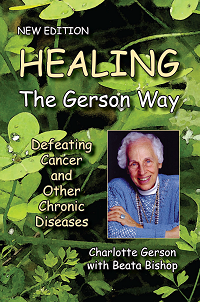| |
Archived from
Charlotte Gerson's book

Story
It
is important to remember that, beside the most common malignancies—
namely, cancer of the breast, prostate and colon, which respond so
well to the Gerson Therapy—the same treatment is just as effective in
healing rare cancers. To illustrate this, we present the case history of
K. G.
Born in 1953, this man was a taxidermist living in Arizona. He was
health-conscious and adopted a careful lifestyle: he didn't smoke or use
drugs and only occasionally drank a glass of wine—but, as he put it, his
diet consisted of "purely junk and convenience foods"! If he ate a whole
wheat bread sandwich, he felt he was on a "health kick"; he didn't touch
salads, which he dismissed as rabbit food. His annual intake of fruit
consisted
of perhaps four apples and two to four oranges. To make things
worse, he didn't realize the devastating effects of the materials he used
daily in his taxidermist business, such as formaldehyde, lacquer thinner,
fiberglass and urethane foam and paints.
Slowly over the years, he became aware of some irritation in his
throat. In due course, swallowing became difficult and his breathing was
heavy. Aged 37, he consulted a doctor and the tests resulted in a
diagnosis
of esophageal cancer. K. G. was reluctant to consider the proposed
treatment, especially in view of the extremely low rate of recoveries, and
searched for an alternative, which turned out to be the Gerson Therapy.
He embarked on it and now admits that it had been a real struggle
to
overcome his aversion to the coffee enemas, but "once I experienced
one, I could feel a difference, and realized their importance." The
patient experienced very long healing reactions and was aware of the
tumor "rotting in my throat with a terrible smell." (12) After some two
and
one-half months, K. G. reports, he felt the remaining tumor falling
down his throat into his stomach. This made him terribly sick for a few
days, but finally he expelled all the toxins and made a full recovery. He
resumed his professional work, but has become extremely careful in the
handling of the chemicals involved, and remains well some 15 years
after his recovery.
REFERENCES
12. Gerson Healing Newsletter 13 (2) (March/April
1998): 5-6.

|
|
